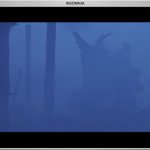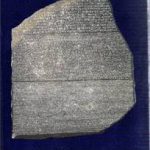2007
Sandy Baldwin identifies Eduardo Kac as a conceptual artist, a forerunner of electronic poetry, and a critical writer whose essays perform their own content: "writing on new media art as new media art."
For Angela Szczepaniak, Canadian poet Stephen Cain visually distorts language by blurring the borders of poetic language and national identity, which are often assumed to be much more clear and distinct than they actually are.
The collection of innovative writing Biting the Error: Writers Explore Narrative is, for Janet Neigh, also a refreshing example of innovation of the anthology genre itself.
Three recent poetry publications by Nate Dorward's press The Gig are reviewed by Greg Betts; these are not poems so much as environments outside of, perhaps astride, the contingencies of systems.
Mike Barrett evaluates Steve Tomasula's The Book of Portraiture in terms of its place between tradition and artistic innovation in the 21st century.
Katherine Weiss revisits Hugh Kenner's playful work of scholarship Flaubert, Joyce, and Beckett: The Stoic Comedians, a book which offers a glance into the more experimental scholarship of 1960s France and provides an analysis that to this day seems original.
In a reading of Christopher Nolan's films (with and against texts by Poe, Wittgenstein, Searle, and Derrida), Walter Benn Michaels examines the autonomy of the work of art.
Stephen Hawkins engages with the "web of counterintuitive, paradoxical, contentious and yet important claims" that he identifies in Gilles Deleuze's Proust and Signs.
Geneviève Brassard defends Gerald Graff's original approaches in Clueless in Academe against his critics - for the problem with Graff's book does not lie between the covers but rather between the ears of those who fault him excessively for sins of omission and commission.
As Christian Moraru argues here that the new is still the objective in contemporary writing. But writers and artists make it by making it anew rather than new ("Get it used," Andrei Codrescu invites us), a new not so much novel as renovated, reframed and reproduced rather than produced, which by the same token redefines and advertises authorship as deliberate plagiarism.
With an introduction by Joseph Tabbi, this collaborative essay by Strickland and Lawson Jaramillo carries the debate into the analysis of specific poems and poetic practices, both written and spoken, graphic and sonic, alphabetically and digitally coded.
Rob Swigart's "Seeking" is a clever and funny story whose roots lie in the materialization of internet interdating connections. Moving through the technological and media reductions of desire, Swigart parallels the overarching theme of "seeking" with a form that is itself punctuated with questions.
Ken Hirschkop questions whether poststructuralism and self-referentiality offer workable alternatives to the military 'World Target' that, according to Rey Chow, provides the framework for knowledge production in Departments of Comparative Literary Studies.
Teri Hoskin, as part of the collection of electropoetics essays on Gregory Ulmer, hypertextually approaches the question of writing and design, of writing as design.
Darren Tofts and Lisa Gye introduce the collection of essays, appearing here in the electropoetics thread, from the Alt-x e-book The Illogic of Sense.
Marcel O'Gorman offers a candid account of what it means to introduce the computer apparatus into teaching in the humanities.
Michael Jarrett practices an Ulmer-inspired heuretics to write about rap.
Jon McKenzie, a former student of Gregory Ulmer's, traces the relations of influence and mentorship.
Linda Marie Walker writes an involved meditation on the concept of the interface and its relation to place.
Niall Lucy enacts a writing that weaves critical and theoretical speculation, rock journalism, hagiography and autobiography.


